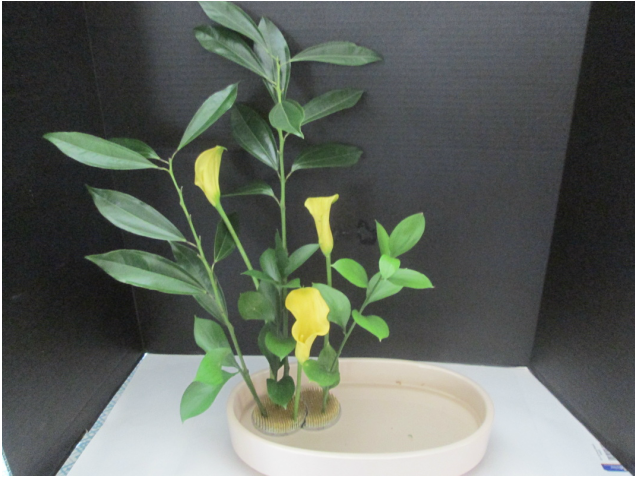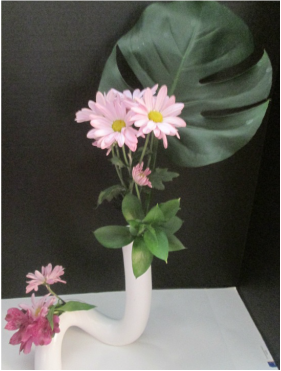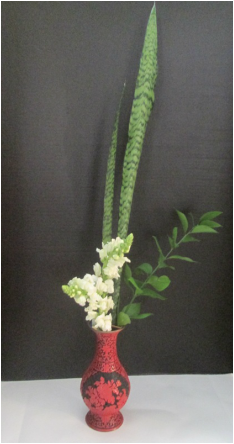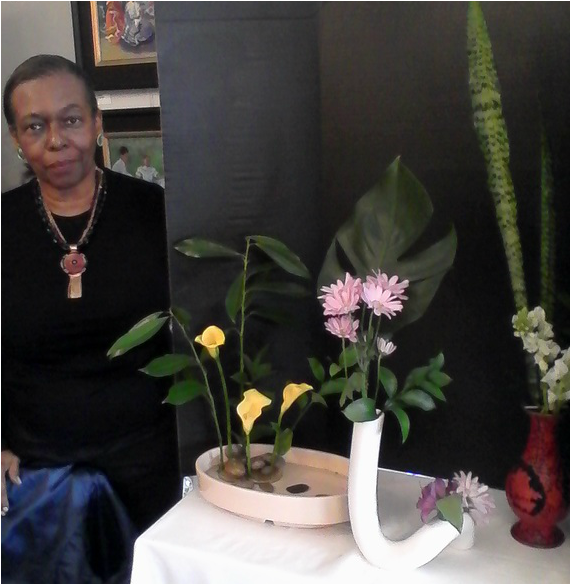Welcome back to IkebanaFuzion. May is a perfect time to think of flowers and Ikebana after a long winter hiatus.
What inspired me to return to posting was a recent lecture and demonstration that I gave at the Fragrant Leaf, a tea boutique in Albuquerque, NM. "SECRET GARDEN" AFTERNOON TEA & IKEBANA DEMONSTRATION, Sunday, April 17, 2016. A demonstration of Ikebana by Mable Henderson* Orndorff, certified Ikebana instructor. Three lucky raffle winners took home materials for an Ikebana arrangement.
Each table was artfully set with teapot and a three-tiered serving stand on lovely linens. It was a floral-inspired afternoon tea with two teas, magnolia blossom-infused oolong and iced lychee with a hint of rose water, and delightful edibles.
In keeping with the concept of Ikebanafuzion, I demonstrated the components of a classical arrangement in a Chinese vase, a moribana in a low flat container, and a freestyle design in a contemporary 21st century container. These spanned centuries of Ikebana with the fusion of forms from various eras.
The first arrangement was in a Chinese Cinnabar vase. I chose this particular container from my collection because Ikebana originated in China and was brought to Japan by a Buddhist monk five or six centuries ago. My vase makes no claim to be authentic or antique; however, it is evocative of ancient Chinese art. (See https://www.realorrepro.com/article/Cinnabar, figures 2, 3, and 12.)
What inspired me to return to posting was a recent lecture and demonstration that I gave at the Fragrant Leaf, a tea boutique in Albuquerque, NM. "SECRET GARDEN" AFTERNOON TEA & IKEBANA DEMONSTRATION, Sunday, April 17, 2016. A demonstration of Ikebana by Mable Henderson* Orndorff, certified Ikebana instructor. Three lucky raffle winners took home materials for an Ikebana arrangement.
Each table was artfully set with teapot and a three-tiered serving stand on lovely linens. It was a floral-inspired afternoon tea with two teas, magnolia blossom-infused oolong and iced lychee with a hint of rose water, and delightful edibles.
In keeping with the concept of Ikebanafuzion, I demonstrated the components of a classical arrangement in a Chinese vase, a moribana in a low flat container, and a freestyle design in a contemporary 21st century container. These spanned centuries of Ikebana with the fusion of forms from various eras.
The first arrangement was in a Chinese Cinnabar vase. I chose this particular container from my collection because Ikebana originated in China and was brought to Japan by a Buddhist monk five or six centuries ago. My vase makes no claim to be authentic or antique; however, it is evocative of ancient Chinese art. (See https://www.realorrepro.com/article/Cinnabar, figures 2, 3, and 12.)
White snapdragons, Sansevieria (mother-in-law’s tongue), and ruscus in cinnabar vase composed this classic upright design. Common names include mother-in-law's tongue, devil's tongue, jinn's tongue, bow string hemp, snake plant and snake tongue. (Wikipedia)
 Springtime Moribana
Springtime Moribana As a nod to spring, the moribana arrangement featured yellow calla lilies with fresh greenery from the grocery store. Remember, you don’t have to have exotic materials for Ikebana. This was the simplest, most straightforward arrangement; it followed the “rules” of most Ikebana schools, using three flowers and three main stems. The shortest green stem served as an assistant to the tallest one, so you will count four stems. Although the Ichiyo School does not insist upon concealing the kenzan, I did cover it with flat pebbles at the demo as I laughingly noted that a bare kenzan offends some people’s sensibilities.
 Freestyle Ikebana
Freestyle Ikebana The final design was contemporary or freestyle. The container defies description, but its sinuous lines spoke to me in a shop display a few years ago, and still today.
Monstera deliciosa provides the dominant force or backdrop for rose-tinted lavender daisies and one short stem of (Ruscus aculeatus) meets the viewer. Common names for these greens are split-leaf philodendron and butcher’s broom respectively. A pop of color in the same color family of the daisies, an Alstroemeria, reaches forward. What conventions are broken here besides the shape of the container?
Monstera deliciosa provides the dominant force or backdrop for rose-tinted lavender daisies and one short stem of (Ruscus aculeatus) meets the viewer. Common names for these greens are split-leaf philodendron and butcher’s broom respectively. A pop of color in the same color family of the daisies, an Alstroemeria, reaches forward. What conventions are broken here besides the shape of the container?
Glad to be back,
Henderson
* Henderson is my middle name, which I've been using on this blog.
Henderson
* Henderson is my middle name, which I've been using on this blog.


 RSS Feed
RSS Feed
